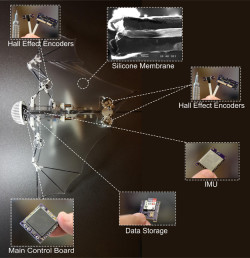Robotic bat
Bats are admired by electronics buffs for their aptitude at ultrasonic echo location. This nocturnal chiroptera also arouses interest with the agility of its flight. The unparalleled aerobatics of the bat offer a model for study and research of aerial robotics, with the key to some formidable technical challenges.

Here is such an autonomous robot, called Bat Bot (B2), which weighs around 93g, and does not try to emulate the complexity of the biological model, but tries to imitate its fluidity of motion. The flexibility of the bat’s wing is much greater than that of the birds and insects which have been studied previously. The ultra fine and very elastic silicon membrane (56µm) of the robot bat form a continuous flexible surface. To conform to the mechanical constraints, primarily weight, it is controlled by a reduced number of actuators which reproduce the dominant degrees of freedom (DOF) of the flight of a real bat. This simplification makes it possible for this robot to fly, as yet only for short distances, but with a promising fluidity!
*Chiroptera: the natural order to which the bat species belong.
